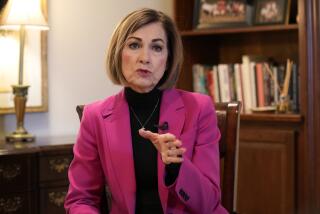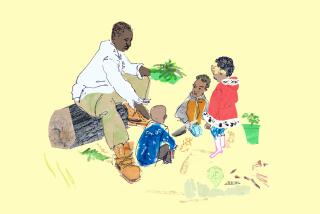Patt Morrison Asks: Alice Waters
Little bistro, huge impact. Like a different sort of miracle of the five loaves and two fishes, Chez Panisse, the landmark Berkeley restaurant, and its founder and guiding spirit, Alice Waters, have leveraged a small temple of slow, local and organic food into a massive force in the culinary world. Now that appetite for a new/old food culture has begun to register on the public’s consciousness, if not always on its plate. Waters is clearing her table of most everything but the Edible Schoolyard Project: If we are what we eat, she wants children in class, on the playground and in the cafeteria kitchen to change their identities by the forkful.
It took nearly 20 years, but finally the White House has the vegetable garden you’ve been urging it to plant. Are you taking your trowel to D.C. to see how it’s going?
I think it’s doing wonderfully. I have a shovel -- a gift from an Italian ironworker -- for the first lady and I have to get it there. Michelle’s interest in bringing schoolchildren in for the groundbreaking was important. She just found a way to make it real.
Now you’ve enlisted Gov. Jerry Brown and Sacramento Mayor Kevin Johnson to expand another long-standing idea of yours, the Edible Schoolyard.
I’ve known Jerry for a long time. I wanted him to validate edible education [with a] task force. I [want] to position edible education in a national way, the way we introduced physical education into public education. Everyone reminded me that to do this in California would really impress the powers that be in Washington.
[And] Kevin Johnson is trying to make Sacramento the greenest place on the planet. I’ve been talking to [him] about [a] program in a Sacramento high school: Kids running the cafeteria, turning it into a business, learn[ing] how to run the business, do the math. Schools [could] apply and have us come in to help work out the curriculum.
It’s the whole nine yards; I don’t see any [other] way of doing it. I don’t think just upgrading food in the cafeteria can work.
You’ve been doing a version of this in Berkeley at Martin Luther King Jr. Middle School for 15 years, and some other schools in California and around the country have similar programs. How does it work?
We have a good test case at Martin Luther King Jr. When they grow it and cook it, they all want to eat it. They like the pride, the control, measuring [planting] beds for a math class. They like being in the garden. They’re learning by osmosis. I’ve watched them; the kids are really talking to each other [about it].
You once had a Chez Panisse Foundation; what’s happened to that?
We decided to let go of the Chez Panisse Foundation because it’s associated with the restaurant work and [focus on] the Edible Schoolyard Project. The website will map the movement, gather all the best practices so people will be able to take what they need for a particular program, like, “How do you save water?” “We live in New Mexico, this is the water catchment system we’re using.”
What’s the state’s role?
They’re going to be cheerleading. They don’t have any money; we understand that. [President] Kennedy didn’t put money into physical education either -- he just gave it credibility and inspired every school to institute physical education. It was part of the curriculum, and that’s the key. This needs to be part of the curriculum too.
Maybe the schools could do what Prince Charles does, selling organic products from his farms.
In Sacramento, they have Seville orange [trees] all over the Capitol grounds. Way back, a grocer in Sacramento made a Capitol marmalade. I said wouldn’t it be great if the gift from the [governor’s] task force could be Capitol Marmalade [that could be sold] for edible education?
The attacks on the first lady for promoting good nutrition and exercise have been shocking, as if it’s un-American.
It’s promoted, I think, by the fast food industry: “We have a right to eat what we want to eat.” That’s their only [defense]. It’s going to persist, and it’s something we can only address in public education.
A whole set of values comes with fast food: Everything should be fast, cheap and easy; there’s always more where that came from; there are no seasons; you shouldn’t be paid very much for preparing food. It’s uniformity and a lack of connection.
Anything political you do now is about food, but back in 1966, you had a fling with election politicking, working to send columnist and former Times staffer Robert Scheer to Congress on an antiwar platform.
When he lost, I was so depressed that I opened Chez Panisse. I said I never want to go into politics again. I just want to be in my own restaurant and feed who I want.
Do you keep your hand in at the restaurant?
I’m always in collaboration with the cooks. I’m bringing back information every time I go away, every time I read a book. We’re all talking about the menus. I think it’s inspiring for them and inspiring for me.
Have you read “American Wasteland: How America Throws Away Nearly Half of Its Food”?
No, but it’s all of a piece. I grew up in a household that had a tiny little garbage can they picked up once a week. My parents had a victory garden so [most] went into compost. And out in front of people’s houses now are three garbage cans. Even if they’re recycling. We have a very indoctrinated idea [against] leftovers. It’s part of the fast, cheap and easy thinking -- don’t sew it, just get a new one. It’s going to be very hard to change those values unless you do it when kids are [as young as] 3.
Writer Adam Gopnik says food culture today is what rock ‘n’ roll was in the 1960s -- our preferences identify us.
I love him; [I hope he] means the good food culture. That I might agree with. Food culture is like listening to the Beatles -- it’s international, it’s very positive, it’s inventive and creative.
But aren’t some people food snobs, talking about food the way people used to talk about wine in New Yorker cartoons? Not what you’re about?
Exactly. [Chez Panisse] never wanted to be more than a little one-star place at most, and then of course we lost our [Michelin] star. I was very happy! I’m sure that by not having that, we lose some people, but [we] brought them in [to] convert them. It took us a long time to use the word “organic” or “sustainable” because I didn’t want to put people off. I wanted to get them to have the peach, love the peach, and then ask where it came from.
Now Wal-Mart is boasting about its organic produce. A good sign?
I think [yes] when the biggest grocer in the world decides they’re going to try to buy locally and organically, even if many of their practices aren’t ones that are good for people.
[However,] it can have a bad effect by knocking all the small local people out of business. People who shop at the farmers markets are always going to shop at the farmers markets, but a lot of people see the price and it costs X amount more.
I’ve been accused of being a farmers market philanthropist, and I love that. I am! Every time I buy in the market, I’m making a donation to my kids’ future.
If you were being immodest, you could take a bow for popularizing much of this -- slow food, local food.
These have been part of civilization for a long time. It’s the way people have been eating since the beginning of mankind -- in rhythm with nature. We are really hungry for that.
Do you ever watch any of these reality-TV chef shows?
I don’t. All of this piques people’s curiosity, and we need that, but what we really need every day is being involved in the schools.
People always complain they don’t have time to cook. How long does it take you to fix dinner?
If I have chicken, I have salad ingredients, I have rice or potatoes and some fruit; I can do it in 10 minutes, as long as it takes to cook the potatoes and saute the chicken breast. If I don’t have it, then it could take me a little longer.
So what’s in your fridge?
You can take a look! I think there are two dozen eggs, some buttermilk that I was making, yogurt. I have sauerkraut; I have some quince paste, one avocado, kale with garlic and onions [that] I sometimes use in pasta. Whole wheat flatbreads made with whole wheat from California; I just put them on the fire, they rise up and get brown.
Do people ever try to catch you eating, say, M&MS? Do you ever backslide?
I backslide to caramel corn. But it’s made with organic popcorn!
This interview was edited and excerpted from a longer taped transcript. Interview archive: latimes.com/pattasks.
More to Read
A cure for the common opinion
Get thought-provoking perspectives with our weekly newsletter.
You may occasionally receive promotional content from the Los Angeles Times.







